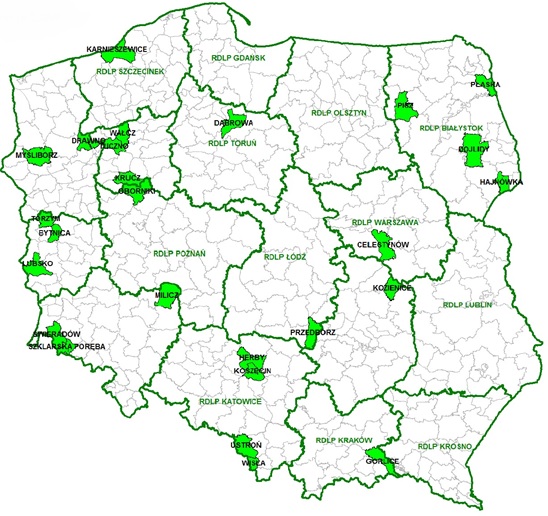10 questions about CFP

- Why is The Carbon Forests Project implemented?
The Carbon Forests Project was masterminded as an answer to progressive negative climate changes. The main factor having the adverse effect on climate is the excessive emission of carbon dioxide (CO2) and other greenhouse gases, e.g. nitrous oxide (N2O). In the Paris Agreement of 2015, forests were indicated as a natural absorber of greenhouse gases, and the necessity to magnify the efficiency of this process this document also emphasised.
The activities implemented within the framework of the project are to increase the forests’ capacity for coal absorption, increase existing carbon resources in the ecosystem, reduce carbon emissions from soils, and reduce the risk of uncontrolled CO2 emissions caused by disasters.
- Where is the project implemented?
The project is implemented in the area of the whole country. At present, the activities are conducted in 23 forest districts, within the territories of 13 Regional Directorates of the State Forests.

- What is an additional activity carried out within the framework of the project?
This is an action that is carried out beyond planned, standard activities in the field of forest management. Within the CFP project, the following additional activities are implemented: afforestation, introduction of fast-growing species such as Douglas fir, introduction of the second storey of trees as well as understoreys, enlarging areas of natural regeneration, and applying techniques preventing excessive damage of the soil surface.
- How long will the additional activities last?
Additional activities, originated in 2017, will be continued till 2024, while their general effect is estimated for 30 years’ time.
- What research is carried out within CFP?
In order to carry out the research objectives, field work is mandatory during which research material is collected. The Bureau for Forest Management and Geodesy, on previously selected research sites throughout Poland, collects samples of organic material from various forest layers, e.g. litter, trees or roots.
Simultaneously, measurements of tree parameters, e.g. their height or the height of crowns, are secured.
Each sample is carefully examined in laboratories - mainly in terms of carbon content. The results of these tests are used to create models such as stand growth curves, which are to replace the variables so far used in the Carbon Budget Model (CBM).
The CBM program was created in Canada and it serves to estimate changes of the amount of carbon in the forest ecosystem. It is obvious that the coal balance model created for forests located so far from Poland requires adjustment to the conditions prevailing in Polish forests.
And this is the main objective of the research, in which the Forest Research Institute (leader of the research consortium), the Institute of Dendrology of the Polish Academy of Sciences in Kórnik, the University of Agriculture in Kraków, the Bureau for Forest Management and Geodesy, and the company Taxus IT Sp. z o.o.(Taxus IT Ltd.) are engaged.
In order to adapt CBM to our conditions, the variables in the existing model are replaced with local parameters, which reflect the characteristics of forests growing in Poland.
- Who can participate in the project?
The Carbon Forests Project has been implemented in multiple directions, which means that many different parties can participate:
- forest districts as units carrying out activities directly in the forest stands;
- private forests owners - currently, the procedure for their participation in CFP is about to be authorised;
- purchasers of the Carbon Dioxide Units as entities buying ’green certificates’.
- What is a Carbon Dioxide Unit (CDU)?
This is the amount of organic carbon corresponding to 1 tonne of CO2 which, as a consequence of additional activities, will be accumulated in tree stands and in soil.
In the second half of 2018, the auctioning of Carbon Dioxide Units is planned. The entire income from the sale of CDUs will be designated by the State Forests for new undertakings indicated by the buyers. These are activities related to the protection of nature and biodiversity, forest and historical education, tourism, e.g. construction or modernisation of bicycle trails, rest areas, parking spaces.
- Who pays for CFP?
The whole project is financed from the State Forests’ own resources.
- How much CO2 does forest absorb?
According to the report Forestry 2017 made by the Central Statistical Office (GUS), the carbon stock in living wood biomass in Poland in 2015 amounted to 822 million tonnes, which is equivalent to 87 tonnes of carbon per one hectare. According to the above mentioned report, in 1900 the respective stock was 467 million tonnes - so one can notice growing tendencies as the indicator is higher and forests in Poland absorb more and more carbon.
Carbon Forests will additionally absorb 1 million tonnes of CO2 during 30 years. In other words, each hectare of forest on which the additional activity will be carried out, will absorb about 37 tonnes more of carbon
- What else do the foresters do for climate?
The CFP is not the only activity supporting the broadly understood climate. All the time the multifunctional and sustainable forest management is carried out. According to the report on the condition of forests in Poland, more than a half (54.6%) of forests, including nature reserves, has protective function. These are mainly water-protective forests, nature valued, suburban, and soil protective. The State Forests also implements the project concerning renewable energy sources, which is the basis for providing electricity to buildings and transportation means of the State Forests. The main objectives are the improvement of energy security, the reduction of greenhouse gases emissions, the improvement of energy efficiency, the popularisation of electric vehicles for road transportation and the dissemination of general knowledge and good practice pertaining to renewable energy sources.

